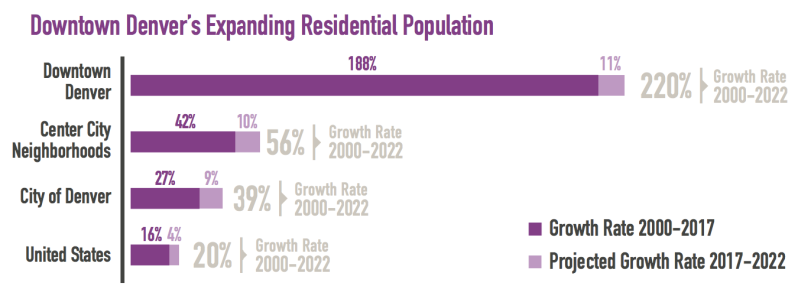Downtown Denver Needs More Transit, Bikeways, and Housing, Not More Parking

More people and jobs are coming to downtown Denver, and the city has to prepare by investing in transit, biking, and walkable development, the Downtown Denver Partnership shows in its annual “State of Downtown Denver” report.
Downtown Denver and its adjacent neighborhoods house 79,367 people. The area has added nearly 16,000 residents since 2010, and will grow by about 8,000 more in the next five years, according to the report.
It’s a far cry from the 1980s, when barren parking lots and empty sidewalks characterized downtown. Back then, commuters came in during the weekday and then retreated to bedroom communities, leaving downtown bare on nights and weekends.
The turnaround of downtown is the result of policies that spurred walkable housing, transit, jobs, and vibrant public spaces. With more growth coming, the DDP report argues that investment in compact development and ways to get around without a car has to accelerate.
“But even as we build out this large scale infrastructure, it’s very important that we continue to look at what the infrastructure is that weaves it all together,” said Tami Door, CEO of the Partnership, at an event yesterday marking the release of the report. “When you come to our center city, it’s imperative that you’re able to move around, whether you’re walking in a very well-streetscaped, safe, welcoming environment, and that you have bicycle opportunities for commuting or recreating.”
Door plugged one of DDP’s top priorities, the downtown loop, an urban biking and walking trail and “linear park.” For three months this summer, Community Planning and Development will demonstrate the concept on 21st Street.
Compact, walkable housing has been instrumental to Denver’s growth, too, Door said, but there’s not enough, and not enough types — even with 5,341 residential units in the pipeline for downtown.
“In order to assure that this residential population continues to grow, and supports our needed workforce demands, we need to make sure that we are offering a variety of housing products — including for sale, certainly for rent, at various price points,” she said. “Including those that meet the needs of growing families, so that we can keep them here in our center city.”
Ken Schroeppel, a University of Colorado Denver urban planning professor and founder of DenverUrbanism, agreed. “We’re gonna continue to need housing but we just need to make sure we’re getting the right mix of housing so we can provide homes for all of Denver’s residents,” Schroeppel said Thursday.
Schroeppel spoke on a panel aimed at identifying the best indicators of economic success. A downtown is nothing without people, he argued, and people cannot live without homes — but many people cannot afford to live in Denver, let alone downtown.
A great way to achieve more affordable housing would be to stop forcing builders to include expensive parking spaces and passing the cost on to tenants and owners.
The Denver City Council is planing to impose new parking minimums on some parcels, but Schroeppel said the city should be establishing parking maximums instead.
“We just really have to think pretty deeply about the cost of housing, and the contributors to housing cost,” Schroeppel said. “If we can build a Denver-centric transit system and through additional pedestrian and bicycle infrastructure, if we can create a way for people to very easily get around central Denver without having to own a vehicle, then that will allow us to decrease the requirement for parking.”


